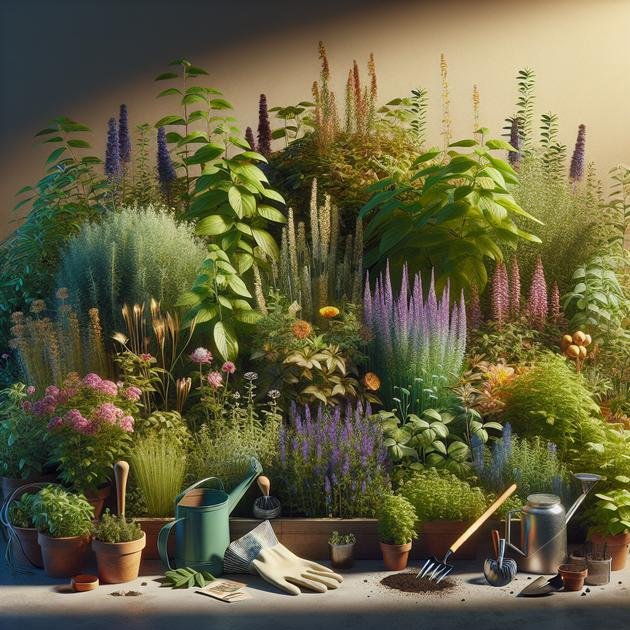Companion planting guide teaches how planting compatible species together improves pest control, soil health, and crop yields naturally for a healthier, more productive garden.
Companion planting guide might just change the way you garden. Ever wondered why some plants seem to thrive side by side while others struggle? Let’s dive into tips and tricks that could make your garden healthier and more productive.
understanding companion planting basics
Companion planting is a gardening technique where certain plants are grown close to each other to provide mutual benefits such as improved growth, pest control, and better yields. By understanding which plants work well together, you can create a natural balance that supports healthier crops without relying heavily on chemicals. For example, planting basil near tomatoes can enhance the tomato’s flavor and help repel harmful insects.
The basics involve knowing which plants complement each other by sharing nutrients, deterring pests, or attracting pollinators. It also includes recognizing incompatible plant combinations that can stunt growth or attract pests. Planning your garden with companion planting in mind means selecting plants that have positive interactions below and above the soil.
Key elements in companion planting
- Growth support: Some plants improve soil nutrients, making them excellent neighbors.
- Pest control: Certain plants naturally repel pests or attract beneficial insects that prey on harmful pests.
- Pollination enhancement: Flowers planted near crops can attract bees and other pollinators for better fruit production.
- Space optimization: Combining tall and low-growing plants makes efficient use of garden space.
By mastering these basics, gardeners can maximize their harvests and cultivate a more sustainable, healthy garden environment.
benefits of companion planting for your garden
Companion planting offers multiple benefits that can transform your garden naturally. One major advantage is improved pest control. By planting certain species together, you can deter harmful insects without the use of pesticides. For example, marigolds help repel nematodes and aphids, protecting nearby vegetables.
Another key benefit is enhanced soil fertility. Some plants, like legumes, fix nitrogen in the soil, enriching it for their neighbors. This reduces the need for artificial fertilizers and promotes sustainable gardening.
Companion planting also leads to better pollination. Flowers such as nasturtiums attract pollinators like bees and butterflies, which boost fruit and vegetable production. Additionally, this technique can optimize space by combining tall and low-growing plants, helping you get the most from limited garden areas.
Additional advantages include:
- Disease reduction: Certain plant pairs help reduce the spread of disease by interrupting pest cycles.
- Improved plant growth: Some companions release natural chemicals that stimulate growth or improve flavor.
- Water efficiency: Plants with different root depths support each other by accessing water from various soil layers.
Using companion planting not only benefits your garden’s health but also creates an eco-friendly, balanced ecosystem.
how companion planting improves pest control
Companion planting improves pest control by using natural plant relationships to reduce harmful insects and protect crops. Some plants release chemicals that repel pests, keeping them away from vulnerable neighbors. For example, planting marigolds near beans can help deter beetles and aphids.
Other plants attract beneficial insects like ladybugs, lacewings, and parasitic wasps. These helpful insects prey on pest species, reducing the need for pesticides. Flowers like dill, fennel, and yarrow are excellent for bringing in these natural predators.
How companion planting disrupts pest cycles
By mixing different plants, you confuse pests that prefer specific hosts. This makes it harder for pests to locate their targets, lowering infestations. For instance, volatile oils released by herbs like rosemary or sage can mask the scent of crops, deterring insects.
Additionally, some companion plants trap pests, acting as sacrificial crops. Nasturtiums attract aphids away from tomatoes, protecting the main crop from damage.
Using companion planting lets you manage pests efficiently and ecologically, reducing chemical use and supporting garden biodiversity.
common plant pairings to avoid

Certain plant combinations can negatively affect growth, yield, or health, so it’s important to know which pairings to avoid. Some plants compete for nutrients, produce harmful chemicals, or attract the same pests, causing problems in your garden.
Examples of common plant pairings to avoid
- Onions and beans: Onions release compounds that inhibit the growth of beans and peas.
- Tomatoes and potatoes: Both are susceptible to early blight and can spread diseases to each other.
- Cabbage and strawberries: They compete for nutrients and can stunt each other’s growth.
- Carrots and dill: Dill may stunt the growth of carrots if planted too close.
- Fennel and most garden plants: Fennel produces chemicals that inhibit the growth of nearly all other plants.
Additionally, planting crops that attract the same pests in close proximity can increase pest problems. Be mindful of plants with similar weaknesses to prevent infestations.
Understanding these incompatible pairings helps you design a healthier garden where plants support rather than hinder each other’s growth.
top companion plants for vegetables
Choosing the right companion plants for vegetables can boost growth, improve flavor, and reduce pests. Some plants naturally complement vegetables by enriching the soil, repelling pests, or attracting pollinators.
Popular companion plants for common vegetables
- Basil with tomatoes: Enhances tomato flavor and repels aphids, whiteflies, and mosquitoes.
- Carrots with onions: Onions deter carrot flies, helping to protect the root vegetable.
- Beans with corn: Beans fix nitrogen, enriching soil for nitrogen-hungry corn, while corn provides a natural trellis for bean vines.
- Cabbage with dill and rosemary: These herbs repel cabbage moths and other pests that harm brassicas.
- Marigolds with almost any vegetable: Marigolds release nematode-repelling chemicals into the soil and deter many insects.
Planting flowers like nasturtiums and calendula near vegetables can attract beneficial insects that prey on pests. Additionally, herbs such as thyme and mint can protect lettuces from pests and improve their flavor.
By strategically choosing and planting these companions, gardeners can create a thriving vegetable garden that needs fewer chemicals and yields more harvest.
companion planting for herbs and spices
Herbs and spices are great candidates for companion planting because they can improve the health and flavor of nearby plants while repelling pests. Many herbs have natural insect-repelling properties that protect vegetables and other garden plants.
Effective companion herbs and spices
- Basil: Works well with tomatoes by enhancing their flavor and repelling flies and mosquitoes.
- Mint: Deters aphids, cabbage moths, and flea beetles but should be contained as it spreads aggressively.
- Rosemary: Repels cabbage moths, bean beetles, and carrot flies; pairs well with beans and carrots.
- Thyme: Protects strawberries and cabbages from pests and attracts pollinators.
- Dill: Attracts beneficial insects such as ladybugs that prey on harmful pests.
These herbs also add fragrance and beauty to your garden, making it a pleasant place to spend time. Many herbs thrive near vegetables, creating a mutually beneficial environment.
When planting herbs, consider their growth habits. Some, like mint, require space or containers to keep them from taking over, while others like thyme and rosemary prefer well-drained soil and sunny spots.
Using companion planting with herbs and spices reduces the need for chemical interventions, promotes biodiversity, and improves the overall vitality of your garden.
using flowers in companion planting
Flowers play an important role in companion planting by attracting pollinators and beneficial insects while repelling harmful pests. Incorporating flowers into your vegetable garden helps create a balanced ecosystem that supports plant health and productivity.
Common flowers used in companion planting
- Marigolds: Known for their strong scent, they repel nematodes, aphids, and whiteflies, protecting nearby plants.
- Nasturtiums: Act as a trap crop by attracting aphids away from vegetables and improving soil quality.
- Calendula: Attracts bees and predatory insects that control pests like aphids and thrips.
- Sunflowers: Serve as natural trellises for climbing plants and attract pollinators and birds.
- Cosmos: Draw beneficial insects such as ladybugs and hoverflies that prey on pests.
These flowers not only help with pest management but also enhance the beauty of your garden. Planting a diversity of flowers ensures year-round support for pollinators and predators of pests.
By strategically placing flowers around your vegetables, you can improve pollination rates, reduce pest issues, and create a more vibrant and productive garden.
soil health and companion planting

Healthy soil is the foundation of a thriving garden, and companion planting plays a crucial role in maintaining and improving soil quality. By planting certain combinations of plants, gardeners can naturally enrich the soil and promote beneficial microbial activity.
How companion plants improve soil health
- Nitrogen fixation: Legumes like beans and peas host nitrogen-fixing bacteria in their roots, converting atmospheric nitrogen into a form plants can use. This enriches the soil for neighboring plants.
- Organic matter addition: Plants with deep roots, such as comfrey, bring nutrients from deep in the soil and add organic matter when their leaves decompose.
- Soil aeration: Root systems of diverse plants improve soil structure by creating channels that allow air and water to penetrate more effectively.
- Weed suppression: Dense planting with compatible plants shades the soil, reducing weed growth and protecting soil moisture.
Rotating companion plants and including cover crops also helps prevent soil depletion and erosion. Using natural methods to boost soil health means fewer chemical fertilizers and a more sustainable garden.
Monitoring soil moisture and using mulch alongside companion planting can further protect soil life and keep your plants growing strong.
how to plan your garden layout with companion plants
Planning your garden layout with companion plants requires careful consideration of plant relationships, sunlight, and space. Start by grouping plants that benefit each other, such as pairing nitrogen-fixing legumes with heavy-feeding vegetables.
Steps for effective companion planting layout
- Map your garden space: Measure and draw a rough plan of your garden, noting sunlight patterns and soil conditions.
- Choose compatible plant groups: Identify which plants grow well together based on pest control, soil needs, and growth habits.
- Consider plant height and spread: Place taller plants to the north or center to avoid shading smaller ones, while allowing low-growing companions to fill gaps.
- Use succession planting: Plan for plants that mature at different times to maximize space and maintain soil health.
- Integrate flowers and herbs: Position pest-repelling flowers and herbs strategically around vegetables to encourage beneficial insects.
- Leave space for pathways and maintenance: Ensure easy access for watering, weeding, and harvesting without disturbing plants.
Rotate plant locations annually to prevent soil depletion and reduce disease buildup. Also, using raised beds or containers can help manage soil quality and plant pairings more effectively.
By thoughtfully planning your garden layout, you can harness the power of companion planting to create a thriving, productive, and sustainable garden environment.
seasonal tips for companion planting success
Seasonal planning is essential for companion planting success because different plants have unique growing seasons and requirements. Understanding how seasons affect planting helps you maximize benefits and avoid issues like frost damage or nutrient depletion.
Spring tips
- Start warm-season companions indoors early, such as tomatoes and basil, to get a head start.
- Plant early cool-season companions like peas and spinach together outside once the soil is workable.
- Use fast-growing flowers like calendula to attract pollinators as soon as possible.
Summer tips
- Maintain companion plantings that provide shade, such as corn with beans and squash (the “Three Sisters” method) to conserve soil moisture.
- Keep an eye on moisture levels, and mulch to reduce evaporation.
- Continue planting flowers like marigolds to deter pests throughout the growing season.
Fall tips
- Harvest warm-season crops and plant cover crops or nutrient-fixing companions like clover to replenish the soil.
- Remove dead plants to reduce disease risk.
- Start planning winter crops and their companions.
Winter tips
- Use mulch and cover crops to protect soil from erosion and nutrient loss.
- Plan companion planting strategies for the upcoming spring season.
- Consider indoor herb gardens with companion plants to extend growing periods.
Adjust your companion planting schedule according to local climate and frost dates for the best results. Seasonal awareness allows you to optimize plant pairings, improve soil health, and maintain a pest-resistant garden year-round.
companion planting in small spaces
Companion planting can be highly effective in small spaces by maximizing the use of limited area and improving plant health. Vertical gardening and container planting are great techniques to combine with companion planting for small gardens, balconies, and patios.
Techniques for companion planting in small spaces
- Vertical planting: Use trellises, hanging pots, or wall-mounted planters to grow climbing plants like beans or peas alongside shorter companions.
- Mixed containers: Plant compatible species together in containers to save space and create mini ecosystems, such as herbs with lettuce or radishes.
- Square foot gardening: Divide small garden beds into a grid, planting compatible companions in each section to optimize yield.
- Succession planting: Rotate crops that mature at different times in the same space to keep the garden productive year-round.
Choose compact and compatible plants that grow well together without overcrowding. Herbs like basil, thyme, and chives pair well with many vegetables in small spaces.
With careful planning and the right plant combinations, even the smallest gardens can flourish using companion planting.
tools and resources for companion planting

Using the right tools and resources can make companion planting easier and more effective. From planning to maintenance, various aids support gardeners at every step.
Essential tools for companion planting
- Garden planner apps: Digital apps help map your garden layout and suggest compatible plant pairings based on your region and soil type.
- Soil testing kits: These kits help analyze soil pH and nutrient levels, guiding your choice of companion plants that thrive in specific conditions.
- Garden journals: Keeping detailed records of planting dates, combinations, and outcomes helps optimize future garden planning.
- Plant markers and labels: Useful for identifying companion groups and tracking growth in the garden.
- Books and online guides: Comprehensive resources provide detailed lists of companion plants, pest control tips, and planting strategies.
Helpful online resources
- Gardening forums and communities where experienced gardeners share advice and troubleshoot problems.
- Interactive companion planting charts that visually display beneficial and harmful plant pairings.
- Videos and tutorials demonstrating planting techniques and garden layouts.
Combining these tools and resources gives gardeners the knowledge and confidence to practice companion planting successfully and sustainably.
troubleshooting common companion planting issues
Companion planting can sometimes face challenges that affect plant health and garden productivity. Recognizing and troubleshooting these issues early helps maintain a balanced garden.
Common problems in companion planting
- Poor plant growth: May result from incompatible plant pairings that compete for nutrients, light, or space.
- Pest outbreaks: Sometimes companion plants fail to repel pests or attract beneficial insects as expected.
- Soil nutrient imbalance: Planting heavy feeders together without replenishing soil nutrients can lead to depletion.
- Disease spread: Close planting might encourage the spread of fungal or bacterial infections.
How to address these issues
- Research and choose proven companion pairs to avoid competition and maximize benefits.
- Observe garden regularly for pest signs and introduce additional natural predators if needed.
- Test soil periodically and amend with organic compost or fertilizers to maintain nutrient balance.
- Ensure proper spacing and airflow between plants to reduce disease risks.
- Rotate crops annually to prevent buildup of pests and diseases.
Keeping detailed garden records helps identify what works and what doesn’t, allowing you to adjust your companion planting strategies for better results.
harvesting benefits of companion planting
Companion planting not only supports healthy growth but also offers significant benefits at harvest time. Plants grown together often yield better because they reduce pest damage and improve soil health, leading to more abundant and flavorful crops.
Improved crop yields
By deterring pests and attracting pollinators, companion plants such as marigolds and nasturtiums help vegetables produce more fruits and vegetables. This naturally boosts the quantity and quality of your harvest without chemical interventions.
Enhanced flavor and nutritional value
Some companion plants enhance the flavor of nearby crops. For example, basil planted next to tomatoes can make the tomatoes taste sweeter and more aromatic. Additionally, healthier soil and reduced pest stress often translate into more nutrient-rich produce.
Extended harvest periods
Certain companion plants can help regulate microclimates within the garden. Taller plants provide shade for sensitive crops, reducing heat stress and extending their productive period. This means you can enjoy fresh produce for longer seasons.
Using companion planting strategically leads to less crop loss and better produce, ultimately making your gardening efforts more rewarding.
myths and facts about companion planting
Companion planting is a popular gardening practice surrounded by various myths and facts. Understanding the truth helps gardeners make informed decisions for their plots.
Common myths about companion planting
- Myth: All plants benefit from being planted together. Not all combinations are helpful; some plants compete for resources or inhibit each other’s growth.
- Myth: Companion planting can replace all pesticides and fertilizers. While it reduces pests and improves soil, it does not eliminate the need for proper care and nutrition.
- Myth: Certain plants always improve flavor. Some claims, like basil improving tomato taste, lack strong scientific evidence but may have anecdotal support.
Important facts about companion planting
- Fact: Some plant combinations repel pests naturally. Plants like marigolds and nasturtiums release chemicals that deter certain harmful insects.
- Fact: Companion planting can improve soil health. Including legumes fixes nitrogen, enriching the soil and benefiting neighboring crops.
- Fact: Beneficial insects are attracted by flowering companion plants. This helps control pest populations and improves pollination.
Separating myths from facts allows gardeners to use companion planting effectively, combining tradition with modern knowledge for a healthier garden.
Wrapping Up Companion Planting
Companion planting is a simple yet powerful way to improve your garden’s health and productivity naturally. By choosing the right plant combinations, you can reduce pests, enhance soil quality, and enjoy better harvests without relying heavily on chemicals.
Understanding the facts and avoiding common myths will help you make smart decisions and create a thriving garden space. With careful planning and the right tools, anyone can successfully use companion planting to grow healthier, happier plants.
Start experimenting with companion planting today and watch your garden flourish in ways you never expected.





